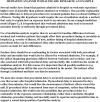Mediation analysis with a time-to-event outcome: a review of use and reporting in healthcare research
- PMID: 30373524
- PMCID: PMC6206666
- DOI: 10.1186/s12874-018-0578-7
Mediation analysis with a time-to-event outcome: a review of use and reporting in healthcare research
Abstract
Background: Mediation analysis tests whether the relationship between two variables is explained by a third intermediate variable. We sought to describe the usage and reporting of mediation analysis with time-to-event outcomes in published healthcare research.
Methods: A systematic search of Medline, Embase, and Web of Science was executed in December 2016 to identify applications of mediation analysis to healthcare research involving a clinically relevant time-to-event outcome. We summarized usage over time and reporting of important methodological characteristics.
Results: We included 149 primary studies, published from 1997 to 2016. Most studies were published after 2011 (n = 110, 74%), and the annual number of studies nearly doubled in the last year (from n = 21 to n = 40). A traditional approach (causal steps or change in coefficient) was most commonly taken (n = 87, 58%), and the majority of studies (n = 114, 77%) used a Cox Proportional Hazards regression for the outcome. Few studies (n = 52, 35%) mentioned any of the assumptions or limitations fundamental to a causal interpretation of mediation analysis.
Conclusion: There is increasing use of mediation analysis with time-to-event outcomes. Current usage is limited by reliance on traditional methods and the Cox Proportional Hazards model, as well as low rates of reporting of underlying assumptions. There is a need for formal criteria to aid authors, reviewers, and readers reporting or appraising such studies.
Keywords: Counterfactuals; Indirect effect; Mediation; Mediation analysis, Survival, Time-to-event, Methodology; Reporting.
Conflict of interest statement
Ethics approval and consent to participate
Not applicable.
Consent for publication
Not applicable.
Competing interests
TL reports personal fees from Novo Nordisk and BeiGene, outside the submitted work. The remaining authors declare that they have no competing interests.
Publisher’s Note
Springer Nature remains neutral with regard to jurisdictional claims in published maps and institutional affiliations.
Figures





References
-
- Valeri L, Vanderweele TJ. Mediation analysis allowing for exposure-mediator interactions and causal interpretation: theoretical assumptions and implementation with SAS and SPSS macros.[Erratum appears in Psychol Methods. 2013 Dec;18(4):474] Psychol Methods. 2013;18(2):137–150. doi: 10.1037/a0031034. - DOI - PMC - PubMed
Publication types
MeSH terms
Grants and funding
LinkOut - more resources
Full Text Sources

